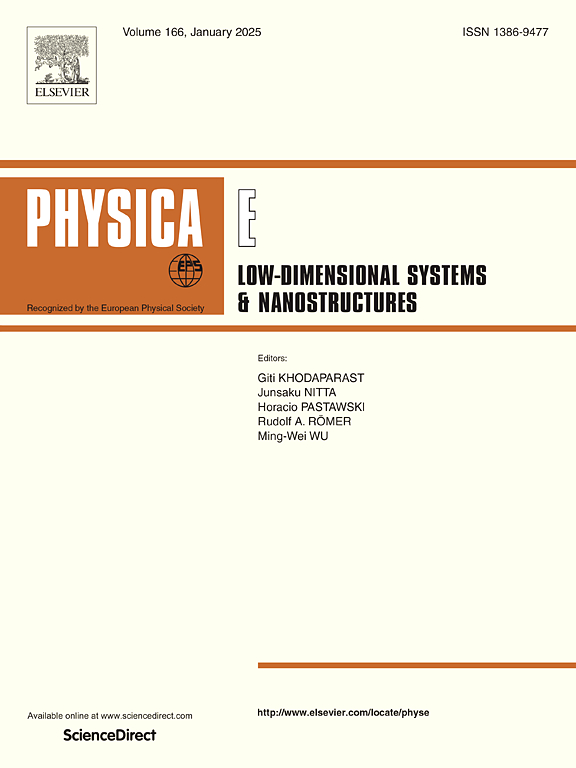VO2/Ag多层纳米结构的相变双带伪装
IF 2.9
3区 物理与天体物理
Q3 NANOSCIENCE & NANOTECHNOLOGY
Physica E-low-dimensional Systems & Nanostructures
Pub Date : 2025-07-04
DOI:10.1016/j.physe.2025.116327
引用次数: 0
摘要
为了解决白天和夜间环境下多光谱探测的挑战,提出了一种集成VO2和Ag的多层纳米结构,用于实线双波段可见-红外伪装。该结构利用法布里-帕姆罗腔中VO2的温度依赖相变特性来动态地修改其结构颜色,从冷色调到暖色调(例如,从580nm的蓝色到436nm的黄色),从而实现背景自适应可见光区域隐身。同时,超薄银层的作用是抑制红外发射率(定义为ε <;0.1 (4-14 μm波段),从而确保在低温和高温条件下与周围环境的辐射对比度最小。仿真结果表明,该结构具有极化不敏感和广角容忍特性(在0°-50°变化期间红外发射率不超过0.1),而能量耗散分析表明,VO2层对可见光具有显著的吸收效应,并由银驱动抑制红外波段。这种变色设计为军事应用中的多光谱隐身提供了一种紧凑、可调节和实用的解决方案。本文章由计算机程序翻译,如有差异,请以英文原文为准。

Phase-transition-enabled dual-band camouflage in VO2/Ag multilayered nanostructures
In order to address the challenges of multispectral detection in day and night environments, a multilayer nanostructure integrating VO2 and Ag for real-line dual-band visible-infrared camouflage is proposed. The structure utilises the temperature-dependent phase change characteristics of VO2 in a Fabry-Pérot cavity to dynamically modify its structural coloring from cold to warm tones (e.g., from blue at 580 nm to yellow at 436 nm), thereby achieving background-adaptive visible light region stealth. Concurrently, the ultrathin silver layer functions to suppress the infrared emissivity (defined as ε < 0.1 in the 4–14 μm band), thereby ensuring minimal radiation contrast with the surrounding environment under both low and high temperature conditions. The simulation results demonstrate that the structure is polarization-insensitive and wide-angle tolerant (the infrared emissivity does not exceed 0.1 during the 0°–50° change), while the energy dissipation analysis indicates that the VO2 layer exhibits a significant absorption effect on visible light and is driven by silver to suppress the infrared band. The colour-changing design offers a compact, adjustable, and practical solution for multispectral stealth in military applications.
求助全文
通过发布文献求助,成功后即可免费获取论文全文。
去求助
来源期刊
CiteScore
7.30
自引率
6.10%
发文量
356
审稿时长
65 days
期刊介绍:
Physica E: Low-dimensional systems and nanostructures contains papers and invited review articles on the fundamental and applied aspects of physics in low-dimensional electron systems, in semiconductor heterostructures, oxide interfaces, quantum wells and superlattices, quantum wires and dots, novel quantum states of matter such as topological insulators, and Weyl semimetals.
Both theoretical and experimental contributions are invited. Topics suitable for publication in this journal include spin related phenomena, optical and transport properties, many-body effects, integer and fractional quantum Hall effects, quantum spin Hall effect, single electron effects and devices, Majorana fermions, and other novel phenomena.
Keywords:
• topological insulators/superconductors, majorana fermions, Wyel semimetals;
• quantum and neuromorphic computing/quantum information physics and devices based on low dimensional systems;
• layered superconductivity, low dimensional systems with superconducting proximity effect;
• 2D materials such as transition metal dichalcogenides;
• oxide heterostructures including ZnO, SrTiO3 etc;
• carbon nanostructures (graphene, carbon nanotubes, diamond NV center, etc.)
• quantum wells and superlattices;
• quantum Hall effect, quantum spin Hall effect, quantum anomalous Hall effect;
• optical- and phonons-related phenomena;
• magnetic-semiconductor structures;
• charge/spin-, magnon-, skyrmion-, Cooper pair- and majorana fermion- transport and tunneling;
• ultra-fast nonlinear optical phenomena;
• novel devices and applications (such as high performance sensor, solar cell, etc);
• novel growth and fabrication techniques for nanostructures

 求助内容:
求助内容: 应助结果提醒方式:
应助结果提醒方式:


